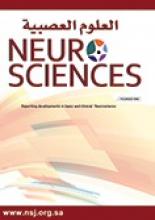Abstract
OBJECTIVE: To define MRI criteria for the presumptive diagnosis of Rathke cleft cyst (RCC).
METHODS: One hundred and three patient MRI scans suggesting RCC performed between January 2005 and January 2011 were retrospectively reviewed for indications, cyst location, T1 and T2 signal intensity, dimensions, encroachment on optic chiasm, enhancement pattern, and stability over a year.
RESULTS: Of the 103 patients analyzed, the suggestion of RCC was an incidental finding in 82.5% (n=85) of patients. Headache was the most common symptom in 11.6% (n=12), visual field deficit in 3.8% (n=4), and both headache and visual field deficit in 0.97% (n=1). The cyst was hyperintense on T1 in 55.3% (n=57), hypointense in 27.1% (n=28), and isointense in 17.4% (n=18). The cyst was T2 hyperintense in 57.2% (n=59), and iso-hypointense in 42.7% (n=54). The cyst showed no enhancement in 80.5% (n=83), and a thin marginal enhancement in 19.4% (n=20). The cyst showed a stable appearance in 99% (n=102) of patients after at least one year follow-up MRI study.
CONCLUSION: Rathke cleft cysts typically have a cystic appearance with T1 hyperintensity, sometimes with T1 iso- or hypointensity, variable T2 signal, and no or thin marginal enhancement and remain stable in size over time.
- Copyright: © Neurosciences
Neurosciences is an Open Access journal and articles published are distributed under the terms of the Creative Commons Attribution-NonCommercial License (CC BY-NC). Readers may copy, distribute, and display the work for non-commercial purposes with the proper citation of the original work.






